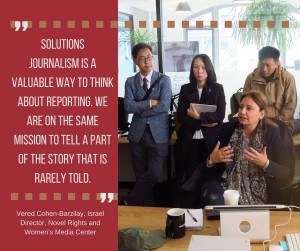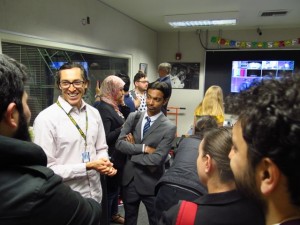Support for free and independent media has long served as a cornerstone of U.S. foreign policy. In releasing the 2015 U.S. Department of State Country Reports on Human Rights Practices, Secretary of State John Kerry focused on this point when he said “Far from threatening the democratic process, a free press and open civil society are the release valve and life blood of a thriving democracy.”

So it makes sense that the earliest U.S. international exchange programs brought journalists here to gain a deeper understanding of the American reality, to meet with their professional peers, and to inform their reporting about the United States.
IVLP projects on the theme of journalism remain popular today, and include large, multi-country initiatives like the Edward R. Murrow Program for Journalists as well as smaller projects. With so many projects featuring journalists as participants, it is important to keep these initiatives fresh, energizing, current, and relevant.
This article aims to share a few ideas and best practices on how to innovate in administering exchange programs for journalists and on the theme of journalism.
- Case study approach—Journalists want more than simply the opportunity to meet other journalists. A case study should examine the background of a story, the reporting process, and journalism’s impact on local communities. A comprehensive case study in a region plagued by drought, for example, might include meetings with environmental journalists, a site visit to a large-scale rainwater harvesting system and a session with the local water authority to talk about how they communicate the need for water conservation through local media. In this way, a series of meetings over a day or two can provide a range of perspectives on a specific issue, showing how it is covered in the press, and the impacts of that media coverage.
- Editorial board meetings—An opportunity to sit in on a local newspaper and/or local TV station news editorial board meeting offers visitors a working-level view of the newsroom decision-making process, i.e. what and how news is covered.
- Shadow a reporter—Visiting journalists routinely note the value of extended opportunities to observe their professional counterparts in action. Arrange for a visiting TV reporter to spend a day shadowing a local television news station as it prepares the evening newscast with the chance to observe planning meetings and to go out on assignment with a news team.
- University schools of journalism—Professors of journalism are routine interlocutors for these groups, and visitors appreciate the opportunity to see first-hand how journalists are trained during site visits to journalism schools. Try to include an opportunity for visitors to meet and interact with students, university campus newspapers, news studios, and research institutes.
- Minority media outlets—Make sure to consider specialized media outlets targeted to minority and marginalized communities. Newspapers and media outlets that serve African American, Latino, Asian, and ethnic communities or for the LGBTI community should not be overlooked. And if your community has a newspaper showcasing the views of the city’s homeless population and sold by homeless people, try getting a meeting with them to talk about inclusion of their experience.
- Social Media—No modern journalism project is complete without discussion of how social media is transforming the media landscape. Consider including prominent community bloggers, new media companies, and social media consultants who can offer another perspective on the diffusion of media voices.
-

Visitors meet with faculty and students at Mira Costa High School to watch a taping of a student produced weekly TV news broadcast. (photo credit: Brittany Lynk) School visit—Provide a chance for participants to examine programs that inspire and train future journalists. Some cities have a magnet high school or specialized middle school that uses student journalism as a tool for project-based learning. A winning program segment might highlight programs that teach media literacy skills by having students produce a newspaper or TV show. And if all parties are willing, a student interview of international visitors is a win-win learning opportunity for everyone.
- Visit a polling station—If a project is taking place during a local election, a journey to a polling station offers a good view of how voters actually cast their votes and what kind of politicking goes on outside. This is always an illuminating process for journalists on any beat.
We know from independent analysis of IVLP programs for journalists that these projects increase participants’ understanding and knowledge of current trends in the media profession, including alternative media and new technologies. “In addition to achieving these immediate outcomes, well-designed journalism projects can provide broader support for press and media freedom all over the world
***
Program Theme Spotlight is intended to promote ideas, brainstorming and best practices on frequent IVLP project topics.
















